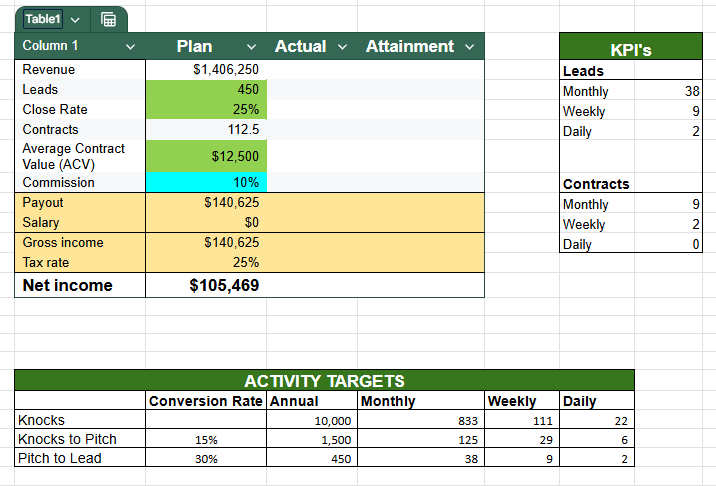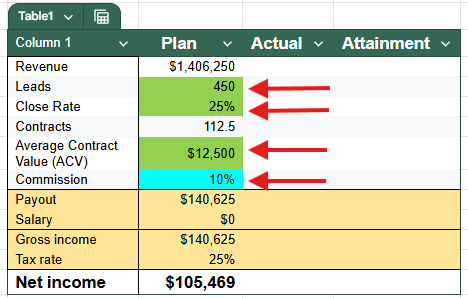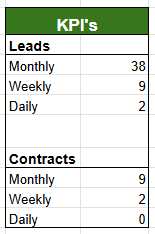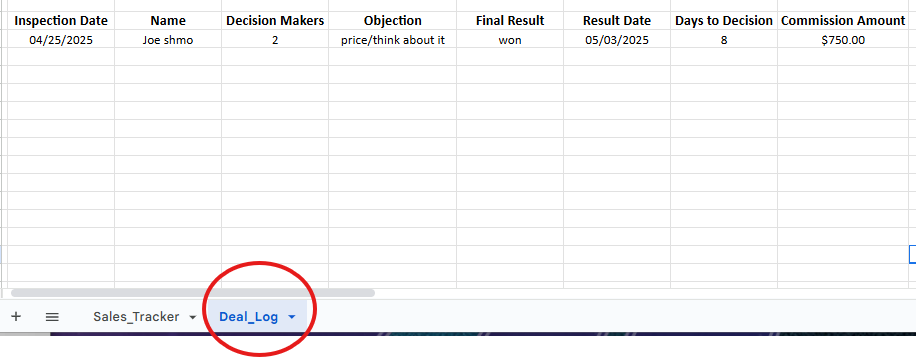Here's The Perfect Spreadsheet If You Want To SMASH Your Roofing Sales Goals (Free Template + Guide)

You can’t hit what you don’t track.
Whether you're chasing $75K, $150K, or a $250K year, tracking your income goal is what separates closers from coasters.
Most roofing reps "think" they’re on pace — until they’re not. That’s why I built a simple spreadsheet that breaks down your income goal into monthly, weekly, and daily targets.
It tracks commissions, close rates, jobs sold, and shows you if you’re winning the game — or falling behind.
No fluff. Just the data you need to dominate.
What You’ll Learn:
- How to use the spreadsheet to reverse-engineer your income
- What metrics matter most for roofing sales success
- How to track commissions, leads, closes, and job value
- Free template download to start now
For a quick refresher on how to get crystal clear on how to set income goals in roofing sales, check out my article here
Why Tracking Your Roofing Income Goals Is Non-Negotiable
I'm gonna be blunt here – if you're not tracking your income goals religiously, you're leaving money on the table. Period.
I spent my first two years in roofing sales hyper focused, and it made all the difference in doubling my income and tripling my net worth.
Guesswork will burn you out faster than anything else in this business. You'll either work yourself to death chasing leads that don't convert, or you'll coast thinking you're doing fine when you're actually way behind.
Both scenarios suck, and both are totally avoidable.
The reps making $200K+ aren't just better salespeople – they track everything daily.
Not weekly, not monthly. Daily.
They know by Tuesday if they're on pace for their weekly goal. I check my numbers every single morning with my coffee. Takes maybe 3 minutes, but it sets my entire day.
Here's the magic formula:
Awareness + Action = Progress.
Without the data, you're just hoping things work out. With it, you've got a clear path forward every single day.
The best part? You'll never have that sinking "oh crap, I'm behind" feeling again. When you're tracking daily, you catch problems early and fix them before they torpedo your month.
That peace of mind alone is worth the few minutes it takes to update your tracker.
Key Metrics to Include in Your Spreadsheet
Alright, let's get into the nuts and bolts of what actually needs to be in your tracking spreadsheet. I've refined mine over three years, and these are the numbers that actually matter.
Start with your annual income goal at the top – mine's $185K this year. Right below that, track your average commission per job. This number changes as you get better at upselling, converting your leads at a higher rate, and targeting bigger projects, so update it monthly. Mine sits around $600.
Your close rate percentage is crucial. Don't use what you think it is – track every single lead for at least two months to get real data.
Mine fluctuates between 40-45% depending on the season and lead quality.
The big three activity metrics are leads generated, appointments booked, and jobs sold. Track these daily because they're the leading indicators of your income. If your leads are down, you know you need to hit more doors or make more calls.
Monthly and weekly revenue targets keep you on pace. I break my $185K into $15,400 monthly chunks, then into roughly $3,850 weekly targets. Seeing these smaller numbers makes the goal feel way more manageable.
Finally, keep a rolling total of commissions earned.
Nothing beats the satisfaction of watching that number climb toward your annual goal. It's like a video game where the points actually pay your mortgage.
How to Use the Spreadsheet (Step-by-Step)
Okay, so you've got all these metrics figured out – now what? Let me walk you through exactly how I use my spreadsheet every single day. This system took me from random $6K months to consistent $13K+ months.
Step 1: Determine what you really want your annual income goal to be. Mine's $185K, but yours might be $120K or $250K – doesn't matter. Just be honest about what you actually want to earn.
Step 2: Enter your average contract value (ACV), closing rate, and number of leads. If you don't know this yet then use 450 leads for the year, 25% close rate, and $12,500 ACV as a starting point and update it after a month of real data. Don't forget to update your commission rate.
The spreadsheet will automatically calculate how many jobs you need monthly and weekly.

Step 3: Let the magic happen. My spreadsheet shows that 9 jobs monthly are needed to hit a $100k+ income goal. Yours might show 25 or 40 – whatever it is, that's your new north star.

It will even calculate how much activity is needed to generate those leads.

Step 4: This is where most people mess up – you gotta log every single job. Date sold, commission amount, and lead source. I do this right after I close each deal, takes maybe 30 seconds but gives me crazy valuable data.

Step 5: Check your monthly pacing chart every Monday. It shows whether you're ahead, behind, or right on track. Green means you're crushing it, red means time to hustle harder. Simple visual feedback that keeps you honest.
Download the Free Roofing Income Tracker
Alright, I know you're thinking "this all sounds great, but I don't want to build a spreadsheet from scratch." I get it – been there.
That's why I'm sharing the exact tracker I use, completely free.
The Google Sheets version is my favorite because it automatically syncs across your phone, laptop, and tablet. All the formulas are already built in – just plug in your numbers and watch it calculate everything for you. No math required on your end.
If you prefer working offline or your company uses Excel, I've got a downloadable version that works exactly the same way. Perfect for reps who spend a lot of time in areas with spotty cell service.
Everything's 100% editable, so if you track different metrics or want to add your own formulas, go for it and make it your own. I built this thing to be flexible because every rep's situation is a bit different.
You can get access to it here by becoming a free member of RoofMoneyPro
This tracker literally changed how I approach my income goals. Stop guessing and start tracking – your bank account will thank you.
Advanced Tips to Maximize the Tracker
Once you've got the basic tracker humming, here's how to supercharge it. These are the tweaks that take your tracking from good to game-changing.
Add separate tabs for:
- Follow-ups
- Referrals
- Upsells
Because that's where the real money lives.
Follow-up tabs show which leads you need to circle back on and when. A referral tab tracks who sent you business so you can send thank-you gifts and ask for more. An upsell tab helps you see which add-ons are working best.
If you have regular 1-on-1s with your manager, bring this tracker.
Instead of vague conversations about "doing better," you can show exactly where you're excelling and where you need help.
Sales managers, being able to view your teams tracker and activity will make weekly meetings way more productive.
Connecting to your CRM is huge if you can swing it. I manually update mine daily, but some reps have figured out ways to auto-sync certain data. Manual updates help me "keep a finger to the pulse", only take a few minutes, and the insights are worth it.
Set up alerts for when you fall behind. I use a simple email notification that fires when I'm more than 10% below my monthly pace. Gives me time to course-correct before it becomes a crisis.
The monthly goal vs. actual comparison is pure gold for improvement. I can see that my summer months consistently beat my goals while winter months lag. Now I plan for that and adjust my activities accordingly.
Mindset Shift — From “Salesperson” to “Sales CEO”
Here's the thing that separates $75K reps from $200K+ reps – it's not talent, it's how they think about their role. Most reps see themselves as salespeople who knock doors and close deals.
Top performers think like CEOs running their own sales business.
A CEO doesn't just work harder when revenue drops – they analyze the data, identify bottlenecks, and systematically fix problems. That's exactly what this tracking system lets you do.
Your spreadsheet becomes your dashboard, showing you exactly where your "business" is winning and losing.
I stopped thinking of myself as just another roofing rep about two years ago. Now I'm the CEO of my own sales operation. My pipeline is my inventory, my leads are my customers, and my tracker is my scoreboard.
This shift in thinking changed everything about how I approach each day.
Weekly reviews give you the confidence that comes from knowing your numbers, the clarity to see what's working, and the control to adjust when things aren't.
Most reps hope they're doing well – you'll know exactly where you stand every single week.
This is honestly how reps scale beyond $200K. They stop winging it and start managing their sales like a business. The tracking isn't just about hitting goals – it's about building a system that generates consistent, predictable income year after year.
Stop guessing. Start tracking.
Whether you're brand new or a veteran in the roofing game, this income goal spreadsheet gives you the clarity to chase — and catch — your six-figure target.